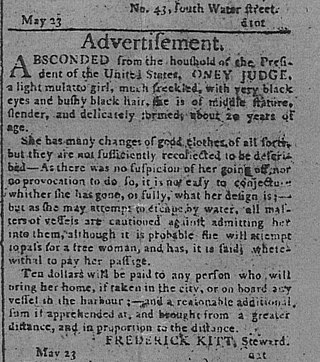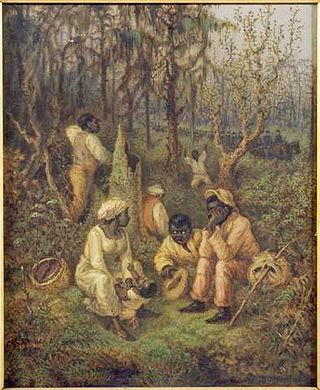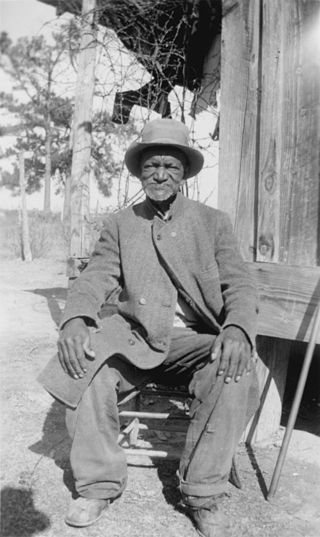Related Research Articles

Gabriel's Rebellion was a planned slave rebellion in the Richmond, Virginia, area in the summer of 1800. Information regarding the revolt was leaked before its execution, and Gabriel, an enslaved blacksmith who planned the event, and twenty-five of his followers were hanged. The site of Gabriel's execution was, for several years, believed to have been at the Shockoe Bottom African Burial Ground, historically known as the Burial Ground for Negroes. His execution was advertised as occurring at the usual place; however, in 1800, that may have been a location other than the Burial Ground for Negroes. The location of Gabriel's burial is also unknown.

The Gullah are an African American ethnic group who predominantly live in the Lowcountry region of the U.S. states of South Carolina, North Carolina, Georgia, and Florida within the coastal plain and the Sea Islands. Their language and culture have preserved a significant influence of Africanisms as a result of their historical geographic isolation and the community's relation to their shared history and identity.

Somerset Place is a former plantation near Creswell in Washington County, North Carolina, along the northern shore of Lake Phelps, and now a State Historic Site that belongs to the North Carolina Department of Natural and Cultural Resources. Somerset Place operated as a plantation from 1785 until 1865. Before the end of the American Civil War, Somerset Place had become one of the Upper South's largest plantations.

Kunta Kinte is a fictional character in the 1976 novel Roots: The Saga of an American Family by American author Alex Haley. Kunta Kinte was based on one of Haley's ancestors, a Gambian man who was born around 1750, enslaved, and taken to America where he died around 1822. Haley said that his account of Kunta's life in Roots is a mixture of fact and fiction.

Old Salem is a historic district of Winston-Salem, North Carolina, United States, which was originally settled by the Moravian community in 1766. It features a living-history museum which interprets the restored Moravian community. The non-profit organization began its work in 1950, although some private residents had restored buildings earlier. As the Old Salem Historic District, it was declared a National Historic Landmark (NHL) in 1966, and expanded fifty years later. The district showcases the culture of the Moravian settlement in the Province of North Carolina during the colonial 18th century and post-statehood 19th century via its communal buildings, churches, houses and shops.

Partus sequitur ventrem was a legal doctrine passed in colonial Virginia in 1662 and other English crown colonies in the Americas which defined the legal status of children born there; the doctrine mandated that children of slave mothers would inherit the legal status of their mothers. As such, children of enslaved women would be born into slavery. The legal doctrine of partus sequitur ventrem was derived from Roman civil law, specifically the portions concerning slavery and personal property (chattels), as well as the common law of personal property.

Ona "Oney" Judge Staines was a biracial woman who was enslaved by the Washington family, first at the family's plantation at Mount Vernon and later, after George Washington became president, at the President's House in Philadelphia, then the nation's capital city. In her early twenties, she absconded, becoming a fugitive slave, after learning that Martha Washington had intended to transfer ownership of her to her granddaughter, known to have a horrible temper. She fled to New Hampshire, where she married, had children, and converted to Christianity. Though she was never formally freed, the Washington family ultimately stopped pressing her to return to Virginia after George Washington's death.

Mike D'Orso is an American author and journalist based in Norfolk, Virginia.

In the American Revolution, gaining freedom was the strongest motive for Black enslaved people who joined the Patriot or British armies. It is estimated that 20,000 African Americans joined the British cause, which promised freedom to enslaved people, as Black Loyalists. Around 9,000 African Americans became Black Patriots.
William Henry Singleton gained freedom in North Carolina and served as a sergeant in the United States Colored Troops during the American Civil War. After its end and emancipation, he moved North to New Haven, Connecticut. There he became literate and a minister in the African Methodist Episcopal Zion Church, serving also in Maine and New York.

Slavery among Native Americans in the United States includes slavery by and enslavement of Native Americans roughly within what is currently the United States of America.

Freedom suits were lawsuits in the Thirteen Colonies and the United States filed by slaves against slaveholders to assert claims to freedom, often based on descent from a free maternal ancestor, or time held as a resident in a free state or territory.

The Great Dismal Swamp maroons were people who inhabited the swamplands of the Great Dismal Swamp in Virginia and North Carolina after escaping enslavement. Although conditions were harsh, research suggests that thousands lived there between about 1700 and the 1860s. Harriet Beecher Stowe told the maroon people's story in her 1856 novel Dred: A Tale of the Great Dismal Swamp. The most significant research on the settlements began in 2002 with a project by Dan Sayers of American University.
Barbara J. Heath is a professor in the Department of Anthropology at The University of Tennessee, Knoxville who specializes in historical archaeology of eastern North America and the Caribbean. Her research and teaching focus on the archaeology of the African diaspora, colonialism, historic landscapes, material culture, public archaeology and interpretation, and Thomas Jefferson.

Slave Narratives: A Folk History of Slavery in the United States is a collection of histories by formerly enslaved people undertaken by the Federal Writers' Project of the Works Progress Administration from 1936 to 1938. It was the simultaneous effort of state-level branches of FWP in seventeen states, working largely separately from each other. FWP administrators sought to develop a new appreciation for the elements of American life from different backgrounds, including that from the last generation of formerly enslaved individuals. The collections of life histories and materials on African American life that resulted gave impetus to the collection.

Ashley's Sack is a mid-1800s cloth sack featuring an embroidered text that recounts the slave sale of a nine-year-old girl named Ashley and the parting gift of the sack by her mother, Rose. Rose filled the sack with a dress, braid of her hair, pecans, and "my love always". The gift was likely passed down to Ashley's granddaughter, Ruth (Jones) Middleton, who embroidered their story on to the sack in 1921.

The 2018 East Carolina Pirates football team represented East Carolina University in the 2018 NCAA Division I FBS football season. The Pirates, led by third-year head coach Scottie Montgomery, played their home games at Dowdy-Ficklen Stadium, and were members of the East Division in the American Athletic Conference. They finished the season 3–9, 1–7 in AAC play to finish in fifth place in the East Division.

Lipscomb House, or Lipscombe House, is a historic Federal-style plantation house in Durham, North Carolina, United States. The Lipscomb Plantation, sitting on 2,000 acres between the Eno River and the Little River, was one of the largest forced-labor cotton farms in Durham County. The plantation was part of the Trading Path, used by Catawba and Waxhaw Native American tribes trading between Petersburg, Virginia, and Hillsborough, North Carolina. The house is now run as a bed and breakfast.
References
- 1 2 Redford, Dorothy Spruill (1988). Somerset Homecoming: Recovering a Lost Heritage. Chapel Hill, NC: The University of North Carolina Press. ISBN 0807848433.
- ↑ Moose, Debbie (9 June 1991). "Woman's journey unlocks powerful past". The News & Observer. Raleigh, NC. p. E1.
- 1 2 Roberts, Frank (21 August 2008). "Work of N.C. history advocate brought lives of slaves to light". The Virginian-Pilot. Hampton Roads, Virginia.[ permanent dead link ]
- ↑ "John Beaver and Dot Redford Retire" (PDF), Carolina Comments, 56 (4): 117–151, October 2008, archived from the original (PDF) on 2012-07-10, retrieved 2014-02-21
- ↑ "Bowles to deliver ECU commencement address" (Press release). ECU News Services. 30 April 2010. Archived from the original on 25 February 2014. Retrieved 21 February 2014.